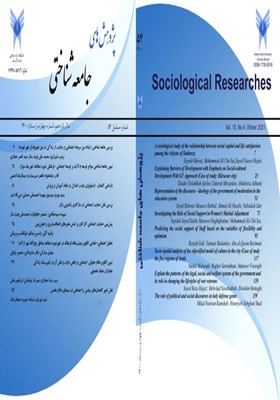تحلیل اجتماعی– فضایی الگویِ عینیتیافته فرهنگ در شهر (مطالعه موردی مناطق پنجگانه شهر اراک)
محورهای موضوعی : در این فصلنامه موضوعات جامعه شناختی در اولویت چاپ هستند و موضوعات نزدیک به جامعه شناسی در اولویتهای بعد قرار می گیرندمهدی مبارکی 1 , باقر ساروخانی 2 , منصور وثوقی 3
1 - دانشجوی دکتری رشته جامعه شناسی فرهنگی، واحد علوم و تحقیقات، دانشگاه آزاد اسلامی، تهران، ایران
2 - استاد جامعه شناسی دانشگاه آزاد اسلامی واحد علوم و تحقیقات، تهران ،ایران
3 - استاد گروه جامعه شناسی، واحد علوم و تحقیقات، دانشگاه آزاد اسلامی، تهران، ایران
کلید واژه:
چکیده مقاله :
این مقاله قصد دارد با استفاده از رویکرد جامعه شناسی فرهنگ، شهر را به مثابه "سازمان اجتماعی تولیدِ فرهنگ" در یک بافتار اجتماعی- فضایی در نظر گرفته که در تحلیل این سازمان، کنش ها و مصارف فرهنگی فرهنگی را بر ﺭﻭﻱ ﻋﻠﻞ غیر فرهنگی همچون اقدامات توسعه شهری قرار دهد تا بتواند به فهمِ الگویِ عینیت یافته فرهنگ در شهر دست یابد. روش این مطالعه ترکیبی بوده که در جمع آوری داده ها هم با ابزار پرسشنامه و همچنین با اخذ اطلاعات موجود اراضی و کاربری ها، مساحت، سهم و سرانه هر یک محاسبه و نهایتا مکانی گردیده است. طبق نتایج، الگوی عینیت یافته فرهنگ در شهر اراک، نابرابر و ناکارا می باشد که تفاوت و نابرابری های فرهنگی جدی را در سطح مناطق و در بین شهروندان ساکن در آن ایجاد نموده است.
In this article, the city is considered as a communication and social organization for the production of culture in a socio-spatial context. In the analysis of this organization (production, distribution and consumption), the culture of cultural consumption is examined Issues such as urban development measures include policy-making, planning and implementation in the allocation and distribution of cultural facilities in order to understand the pattern of cultural justice in the city. In this article, the city is considered as a communication and social organization for the production of culture in a socio-spatial context. In the analysis of this organization (production, distribution and consumption), in order to understand the pattern of cultural justice, cultural consumption is examined. Issues such as urban development measures include policy-making, planning and implementation in the allocation and distribution of cultural facilities in order to understand the pattern of cultural justice in the city. The method of this study was a combination that in the quantitative part, data collection was done with a questionnaire and sampling method appropriate to the volume. In the quantitative part, information related to physical studies was performed with secondary analysis and then location. According to the results, the spatial distribution of culture in Arak is inefficient and unequal and faces serious shortcomings in the urban planning system in Arak in the regions and among residents.
_||_


